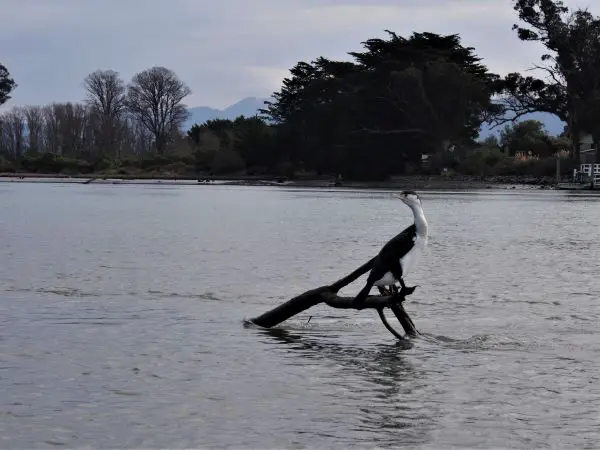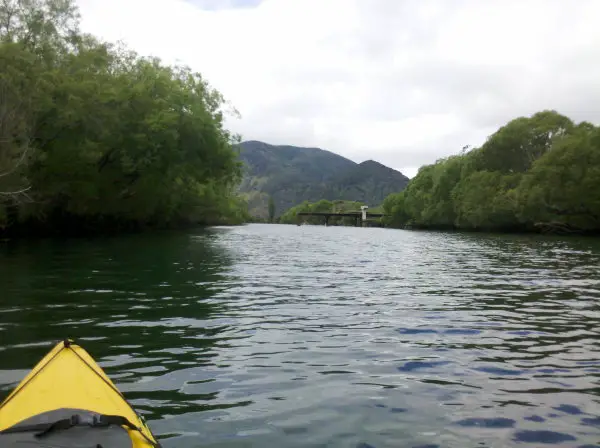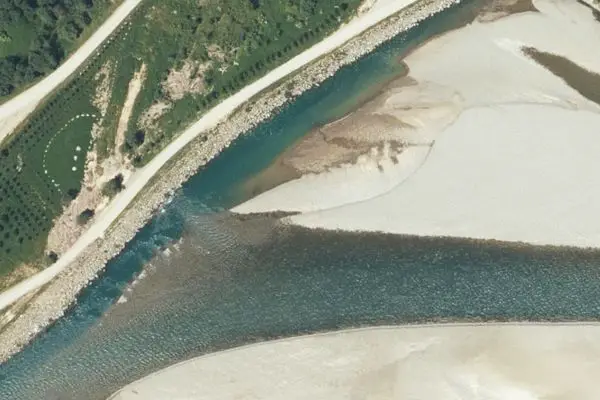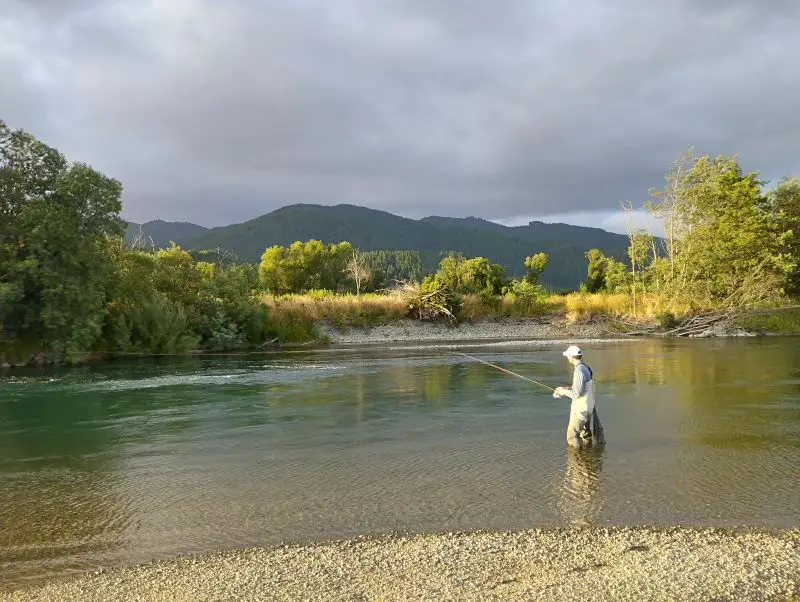Today, I thought I will share the prime locations to cast when attempting to catch a trout. There is a lot of water out there, and trout usually only hold and feed in a small portion of it.
Knowing where to cast can greatly increase the odds of catching a fish.
Submerged trees – because they provide shelter and food.

When I see a submerged tree or even just a trunk it is always worth a cast or ten. It does not matter if the tree is in a stream, river, or lake. I am going to fish around it. Likewise, still or fast water. I am going to fish it.
Trout love to hang around sunken trees because they offer so many opportunities for them.
The branches of the tree provide shelter for the trout to hide in, and just like a large rock out in a rapid, a tree trunk disrupts the current creating an area of slower water where a trout can rest while feeding.
Finally, smaller fish hang around submerged trees for the same reason. So trout often cruise around them hoping to snatch a minnow before it can dive back under cover.
What are the downsides to fishing around submerged trees? Will, it is very easy to snag on the branches, so there is always some risk of losing tackle. I have swum in a few trout pools before, and sometimes the branches look like Christmas trees with so many lost lures hanging from them.
For this reason, I like to fish floating lures when targeting trees, that way I can float them up and over any branches. In another article, I have gone into more detail on how to fish floating lures around submerged branches.
Also, inline spinners such as rooster tails work well. This is due to the long willow leaf blade that at times can deflect the lure away rather than snag into a branch.
My last piece, of advice, is that single hooks snag less often than treble hooks. Also once, snagged a barbless hook is more likely to fall free than a barbed one.
Fish around rocks in the current
A large rock in the middle of a flowing river must be one of the most iconic locations to find trout. That is because the rock diverts the current, creatinine an area of slower water where they can rest while feeding.
One piece of advice, trout are just as likely, if not more so to be holding upstream of the rock as downstream. That is because the rock splits the flow of the river, creating a patch of slow water upstream. There the trout can rest and have an unimpeded view of everything floating toward them. So make sure to cover both directions.
In still water, such as in a lake or pond. Rocks are much less likely to hold fish. There might be a few sheltering beneath it in an overhang but they are not normally in a feeding mood. So, I might give a rock in a lake a couple of quick casts, but I am not going to prioritize it.
The extreme shallows
When fishing a river or stream, a surprising number of trout seem to hold right close to the shore. I have lost count of the number of trout I have spooked that were resting in only a few inches of water. I suspect they hold there because the current is slower closer to the shore.
For this reason, it is always a good idea to cast upstream and cover the shallows right next to the shore before moving upstream. It is a bad feeling spooking the only trout in a pool because it was sitting in ankle deep water.
I also want to note, that sometimes sick trout also happen to rest in the shallows. Their skin often darks and they become very lethargic. At times, I have given such fish a nudge with my boot to see if they were still alive.
When I spot such a trout while fishing, I normally cover it a few retrieves, before moving on. They do sometimes take spinners, but more often than not they are living skeletons.
Foam lines – That is where trout feed.
Foam lines usually occur downstream of rapids or waterfalls where the water starts to slow. A foam line is an area in the current where small lines of bubbles seem to flow.
Trout like foam lines because it is an area of the flow that is carrying the most dislodged food, so trout are likely to be feeding nearby.
Some people also believe that the foam provides some protection against overhead predators such as eagles or osprey, I am not convinced, but it does not really matter because trout often hold beneath foam lines while feeding.
When fishing foam lines, I like to cast upstream and retrieve back down ever so faster than the current. Remember the trout will be facing upstream, looking for morsels floating down.
Overhanging branches provide shelter and food.

A thicket of overhanging willow branches, or even a lone tree. These are prime locations to find trout because it provides excellent protection from above. At certain times of the year, terrestrial insects also drop from the branches providing even more reasons for the trout to be there.
It is also a very difficult area to fish. I have lost countless lures, both casting into and fighting fish out of such locations. But, in my opinion, it is worth the effort. For some advice on how to free snagged lures check here.
So, how to get the lure into where the trout are holding?
Sometimes, it is possible with a flick of the rod to try and skate the lure across the surface. A bit like skipping a zone. When done correctly, it is possible to cast into very tight places, although it is very easy to miscalculate and end up catching a branch instead.
Other times, I like to position myself upstream of the tree, flick my lure out a few feet and slowly let it drift downstream under the current. Once far enough down, I can slowly retrieve it back up.
Likewise, at times when fishing floating Rapala I will cast out wide, and close my bail arm. I then let the current pivot my lure back around so it is directly downstream of where I am standing. Then it is only a matter of retrieving it back to where I am standing. Using this technique does run the risk of snagging submerged branches.
Plunge pools.
The pool directly downstream of a waterfall or steep rapid often hold good numbers of trout. Depending on the depth of the pool, trout can hold quite close to the surface, or very deep down.
In deeper plunge pools, it can be beneficial to fish spoons or other lures that sink quickly.
It is not only the depth of a plunge pool that makes them worth fishing, they often form an upstream barrier to migrating fish. This means any trout trying to move upstream can become trapped beneath a such barrier.
River mouths are prime locations for catching trout
I love fishing river mouths, I have even written a whole article on them.
River mouths are a prime spot to target trout because the trout gather there for a number of reasons. In the summer, they are often there because side streams often flow cooler. So they find refuge from the heat directly downstream of the inlet.
In the fall, or spring. Trout on their spawning migration often gather at river mouths, while waiting for rain to raise the water level enough to allow them to migrate further upstream.
Backwaters

I love fishing backwaters, they are like a little still water section directly connected to a large river. They are most common on braided rivers or rivers with multiple channels, but they can form on meandering and any river type for that matter.
Backwaters are usually formed when an old river channel gets disconnected from the main flow. They get most of their water from springs, or by back fulling from the main channel. They are often deeper, colder, and the water clearer than the main channel
Backwaters usually offer excellent trout fishing because the water is colder than the main channel, all of those springs keep the water several degrees cooler. I often swim in them during the summer, and sometimes the water temperature is outright frigid.
I normally fish backwaters like any still water, and target the shallows and any structure. Trout are more likely to cruise around grabbing nymphs and dries than hold in place.
The mouth of the backwater, where it empties into the main channel is also worth a look. Although, I usually have better fishing further back.
The shallows at the head of a rapid
Many people fish directly downstream of rapids, where they enter into a pool. This is a good idea because plenty of trout hold there.
But, a good number of trout, also hold upstream of the rapids just where the water starts to accelerate. Trout in this slightly faster flowing water is nearly always feeding. So this interchange zone, at the head of a rapid, or a tail of a pool is certainly worth a few casts.
Shallow flats in still water fisheries hold many trout
Let’s discuss still water for a moment. Throughout much of the year. Shallow, flats hold a surprising number of feeding trout.
I believe the trout are there because the flats warm faster than the surrounding water, meaning when the water is cold, the flats will be home to the most aquatic life. So they are there to feed.
Sometimes, they even push into shallow little inlets or bays.
For even more information on fishing the shallows, check my guide here.

